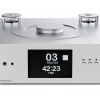I often have people ask me some very basic overall questions about the acoustical design of a room, such as:
- How much will it cost?
- What will it look like?
- How much better is it going to sound?
All of these are important questions and sometimes it’s difficult to give someone an answer that’s easily understood.
First of all, all of those questions depend greatly on the client. What are the client’s needs? I tell all of our clients when considering the acoustical engineering of a room, consider three aspects: Aesthetics, Budget, and Sonic Benefit. Every client has a different threshold for each, thus every room will be different. If you want great aesthetics, it’s necessarily going to cost more to build. A certain level of performance or “Sonic Benefit” is required or you would not be acoustically engineering the room in the first place.
This explanation helps, but does not nail it down to concrete and easily understood numbers. Will it cost $5000 to build or $50,000? It is impossible for us to know precisely, this is why every project should be put out for bid, no matter how large or small. However, we can steer designs in certain directions. Let’s take another aspect: sonic benefit. How do you measure that? Well, as acoustic engineers we can measure certain objective performance criteria, but that does not necessarily relate precisely to “how good does it sound?” You can actually have a room that measures beautifully, but sounds horrible. So measurements don’t tell you everything, they simple act as a guideline or check to insure performance as expected. So that still leaves the question, “how good does it sound?” and there is no objective criteria to how good something sounds. As an example: there are watts for amplifiers–this has no correlation to how good the amplifier sounds, there are efficiency (db/watt) ratings for speakers, and again no correlation to how good the speakers sound. In the end, there is not a measure to how good the room will sound. That makes undergoing the design and build process a possibly daunting task. It’s expensive, and it’s not something you are going to trade in next month when the “new cable of the month” is released.
The point above is important and should not be taken lightly. One of my favorite quotes is: “Audio Equipment changes every year… rooms don’t.” Take this to heart when designing a room and consider the three aspects carefully, and if you are hiring a professional group, consider the investment and how long you will likely be using this room. A sizeable investment may warrant a trip to one of the rooms that group designed and certainly would warrant speaking with, or at least e-mailing, some of the prior clients. Look on the web and Internet forums. What do people say about the designers and engineers?
In a previous article we discussed the process of designing a room. The four basic stages:
- Dimensions
- Ergonomics
- Concept
- Schematics
Now, let’s look at the preliminary planning phases of the project, some of the more abstract ideas that correlate to:
- Aesthetics
- Budget
- Sonic Benefit
Kitchen Comparison
I figured most people reading this article have probably designed a kitchen at one time or another or at least remodeled one in their home. I’m going to use this as an example in understanding some of the aspects of designing a room. First let’s look at different types of kitchens: There are ones in your home, there are small ones in an apartment, there are large ones that connect into a family room, there are professional ones in restaurants and cooking schools. The basic function of the kitchen is the same–it’s to prepare meals, but the specifics of the kitchen are just as variable as the specifics of a media room. Take for instance the professional kitchen. It has lots of stainless surfaces, cooking ranges capable of much higher temperature than residential stoves and ovens, huge storage capacity for ingredients, pots and pans hanging from the ceiling. Many people can cook at once and there are stations designed for specific tasks to be accomplished. Would you want a kitchen like this in your home? Some people would want a scaled down version in their home. And that’s okay. It’s your home and you know your needs and wants better than anyone else. I equate a professional kitchen to the likes of a recording studio. Very utilitarian and while it can be beautiful to some people, it may look very avant garde to most. Some of the listening rooms we’ve designed have many aspects used in recording studios. This aesthetic appealed to these clients and we designed the room in such a way.
One of the ways I correlate the kitchen to a media room is to ask the client to consider the appliances as their equipment. The cabinetry and countertops are the acoustical treatment. The budget of the room will be comprised of what they spend on their equipment (appliances) and the acoustical devices (cabinetry/counter tops). Since we are talking about the acoustics, we will first look at the cabinetry and counter tops issue. If you want a beautiful kitchen with natural cherry cabinets and granite countertops it’s going to cost more than a Formica finished kitchen. The Formica one will hold your dishes just as well, but cost a lot less. The same is true in acoustics. If you want beautiful hardwood finishes and fabrics with an intelligent integrated decor it’s going to cost more than simple (often pre-fabricated) solutions.
Now let’s consider the appliances. Yes, these can obviously affect the budget too, but I really want to address using appropriate appliances more than budget issues here. In an apartment kitchen that’s only big enough for 2 people in it, would you put the Viking 8 burner stove and double convection oven? I doubt it too. Then why are you trying to put the largest pair of speakers known to man and a 1000 watt amplifier in an 11 x 13 listening room? It makes just as much sense–none. Consider your space and consider your equipment to be appropriate for that space.
Back to our kitchen design. How do you really use your kitchen? Do you cook alone in it and serve to others, or are there many people helping out in the kitchen? Do you entertain in the kitchen–does it become the central location when you have parties? These types of questions should be asked when designing a media room. How many people will use it? Will you entertain in there or is it mainly for 2 people? How should you layout your kitchen? Have you ever been in a kitchen where things were located in the wrong place? The dishwasher was on the opposite wall as the sink, and there was no counter space next to the refrigerator. The glasses and dishes were stored away from the dishwasher. Chances are you haven’t been in too many kitchens like this, and for a good reason. People have been designing and using kitchens for a long time. People almost automatically know these basic aspects that you should consider when designing a kitchen. Form follows function is the golden rule in designing a kitchen and it should be as well in designing a media room. Chances are that you may not have designed a media room before and many of these basic principles could easily be forgotten. A good designer/engineer can help you with these things. For example, don’t have a side mounted speaker on an aisle that everyone is going to hit their head on. You can’t imagine how often this mistake is made. Also, don’t create unnecessary up and down steps for that riser in the back of the room. The interior designer might think it looks cool, but functionally it has no purpose and you will grow tired of the added steps quickly. They become simply something to trip over. Other things to consider are where is the equipment rack going to be located, how will it be accessed, and where is the media? You would be surprised how often things like this are left out. I want my media close to the equipment, not in the next room. Just like I want the dishwasher close to the sink.
Just like a kitchen, the process is expensive and not something you want to do twice, so plan properly. Just like designing a kitchen it is likely you will have to make some choices and compromises. You may have really wanted the granite countertops, but they just came in over budget, you can still get a great kitchen. Also you may have dreamed of that Viking stove, but can’t get the ventilation required by the city’s Building & Safety codes to have that model. This would be like not being able to get the seats far enough back to have a proper viewing distance for that 10 foot screen you wanted. So consider your decisions carefully and understand the compromises. A good designer/engineer can educate you enough to understand the importance of each of these decisions.
Lastly, enjoy the process. It’s truly fun because you are making the decisions for a room that you will enjoy a very long time.
by Richard Bird, President, Rives Audio





























